August 15, 2012
I Have Joined An Elite Group.
Every hobby has a "holy grail." For us American rubber duck collectors, it's usually the Tolo Duck. For those who collect baseball cards, it's the American Tobacco Company's T206 Honus Wagner. Car collectors have different tastes... for one, it'll be a cherry '68 Mustang fastback, but another will only look at Dinos... for whatever reason. But when you're an amateur military historian of the Pacific War like I claim to be, what's the goal? Kaigun, Sunburst, Shattered Sword, The First Team, A Glorious Page In Our History... all of these are on The Shelf. In the comments of that post, CXT mentioned a title I wasn't familiar with. I looked into it and immediately began salivating: it seemed like it pushed every activation button in my brain at once. Full of histories and detailed to the extreme, it was exactly what I look for in a mil-hist book. That it's also considered one of the best references of all time helped a lot, too... until I took a look at the prices.
Holy jumpin' guacamole on a stick, $300??? Yeah, not so much. However, I kept an eye on the Amazon price listing... every now and again, it'd drop to $200, and I vowed to myself that if I had the cash on hand if the price fell to $150, I'd go for it. It still felt ridiculous spending that much on a book, but then I realized that college students spend twice that much and more on books all the time. Eh, whatever, it's only money. Last Friday, I clicked the link to Amazon, and...
Holy jumpin' frijoles in a hot tub, $150. I couldn't click on the purchasing link fast enough. Today, this Holy Grail that has been out of print for at least 10 years and had a list price of $75 in 1997... was delivered unto my hands.
And just what is this paragon of the mil-hist world?
more...
Holy jumpin' guacamole on a stick, $300??? Yeah, not so much. However, I kept an eye on the Amazon price listing... every now and again, it'd drop to $200, and I vowed to myself that if I had the cash on hand if the price fell to $150, I'd go for it. It still felt ridiculous spending that much on a book, but then I realized that college students spend twice that much and more on books all the time. Eh, whatever, it's only money. Last Friday, I clicked the link to Amazon, and...
Holy jumpin' frijoles in a hot tub, $150. I couldn't click on the purchasing link fast enough. Today, this Holy Grail that has been out of print for at least 10 years and had a list price of $75 in 1997... was delivered unto my hands.
And just what is this paragon of the mil-hist world?
more...
Posted by: Wonderduck at
05:00 PM
| Comments (12)
| Add Comment
Post contains 568 words, total size 4 kb.
August 07, 2012
All Along The Watchtower
The weather the previous few days had frankly been lousy. The ships had been pitching and rolling in a way destined to make everybody who wasn't either a natural sailor or possessing good sea legs rather uncomfortable. Alas, most of the men on board the fleet were neither. Still, nobody begrudged the weather; it kept them hidden from eyes that would be very interested indeed at their presence.
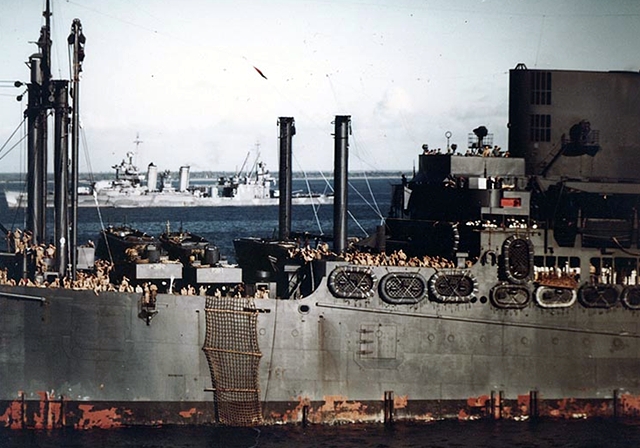
As the sun broke over the horizon that morning, the fleet broke into two task groups. TG Yoke headed to the north, while TG X-Ray steered south, towards the larger of the cluster of islands. Simultaneously, escorting ships raced ahead to deliver a short, sharp bombardment. Overhead, planes wheeled around the sky, swooping down to deliver their payloads, then return to their carriers. Below, the transport vessels began disgorging men and machines into landing craft for the run to the beach.
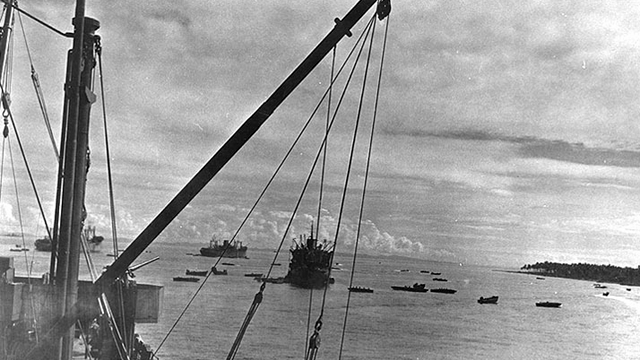
In the landing craft, the men were tense and prepared for everything. Everything, that is, except for what they got. While to the north resistance was remarkably heavy, to the south the landing craft and amtracks were pretty much unopposed. By the end of the first day, somewhere around 10000 men were well on their way to having landed on that island to the south. The main enemy being reported was a nigh-on impassable jungle. Still, nearly 1000 yards worth of progress had been made and the major objective was near at hand.
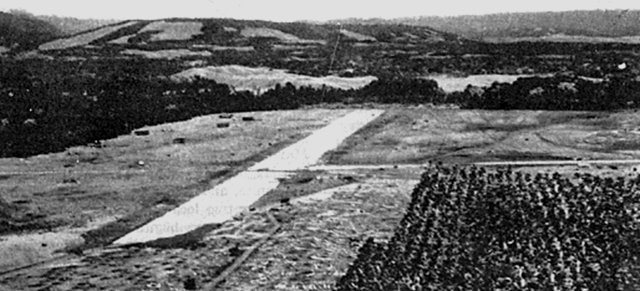
In the coming days and months the battle for this island would become a meatgrinder for both sides, chewing up men and machines and spitting them out with total disregard. On that first day, however, the landing on the southern island gave no indication of what was to come.
The day was August 7th, 1942. The island was Guadalcanal. 70 years ago, the War in the Pacific entered a new phase: the Allies went on the offensive. That phase would continue until the end of the War.

As the sun broke over the horizon that morning, the fleet broke into two task groups. TG Yoke headed to the north, while TG X-Ray steered south, towards the larger of the cluster of islands. Simultaneously, escorting ships raced ahead to deliver a short, sharp bombardment. Overhead, planes wheeled around the sky, swooping down to deliver their payloads, then return to their carriers. Below, the transport vessels began disgorging men and machines into landing craft for the run to the beach.

In the landing craft, the men were tense and prepared for everything. Everything, that is, except for what they got. While to the north resistance was remarkably heavy, to the south the landing craft and amtracks were pretty much unopposed. By the end of the first day, somewhere around 10000 men were well on their way to having landed on that island to the south. The main enemy being reported was a nigh-on impassable jungle. Still, nearly 1000 yards worth of progress had been made and the major objective was near at hand.

In the coming days and months the battle for this island would become a meatgrinder for both sides, chewing up men and machines and spitting them out with total disregard. On that first day, however, the landing on the southern island gave no indication of what was to come.
The day was August 7th, 1942. The island was Guadalcanal. 70 years ago, the War in the Pacific entered a new phase: the Allies went on the offensive. That phase would continue until the end of the War.
Posted by: Wonderduck at
08:30 PM
| Comments (3)
| Add Comment
Post contains 333 words, total size 2 kb.
August 02, 2012
Stay To Port!!!
Like many monitors, the HMS Lord Clive and her sister ship HMS General Wolfe were armed in a ridiculous manner. Of course, that's pretty much the very definition of a monitor: heavy weaponry on a smallish hull. In the case of these ships, they weighed in at just under 6000 tons... bigger than a destroyer, smaller than a light cruiser. They were just over 330 feet long, had "meh" armor, and like most monitors, they were slower than molasses. Indeed, they could make a whopping seven knots at full power. A lot of that came down to her beam: 87 feet from side to side if you count the torpedo bulges. You could drop the engines from an Iowa-class into one of these ships and they still wouldn't be fast with a length:beam ratio of 4:1. Of course, speed isn't what a monitor is for... big ol' guns, that's what monitors are for.
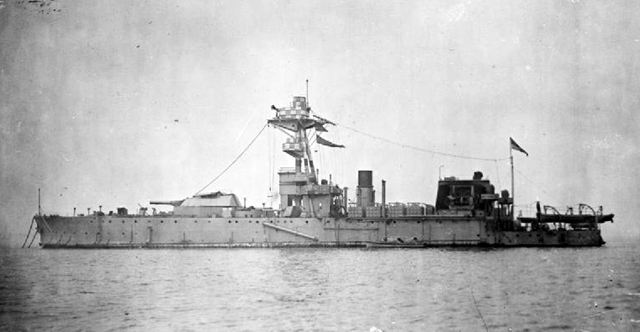
The Lord Clive and General Wolfe looked like they were pretty heavily armed, what with that big honkin' turret up front, carrying two 12" rifles. That's pretty impressive on a 6000 ton hull, but that's not why they always said to stay to the port side of these ships, no no. No, there was a very good reason for that!
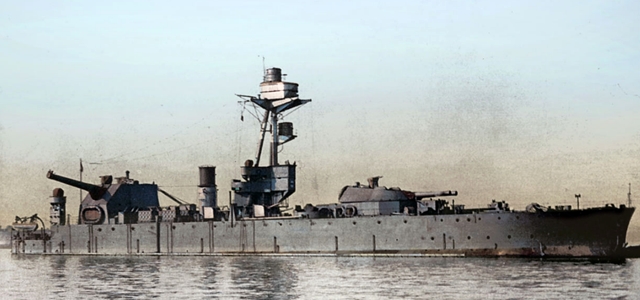
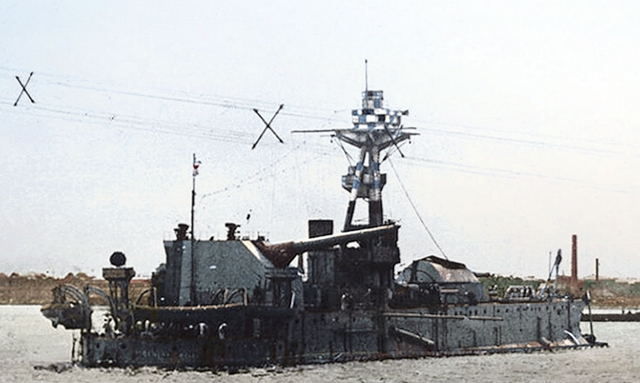
What appears to be a turret on the stern is really just a big blast shield with an open back. It couldn't rotate at all, though the gun could swivel within a 20° arc. It really wasn't intended for use against enemy shipping, but for shore bombardment. To be fair, the two ships weren't particularly good at their job, as their guns could outrange any sighting equipment on hand, save aircraft of course... which didn't carry any radio to speak of at the time. Still, there must be an incredible horror when you realize that someone is throwing 3000+ pound shells at you from well over the horizon.
After WWI ground to a halt, the General Wolfe was paid off and broken up in 1921, while the Lord Clive lasted until 1927 as a gunnery trials ship.

The Lord Clive and General Wolfe looked like they were pretty heavily armed, what with that big honkin' turret up front, carrying two 12" rifles. That's pretty impressive on a 6000 ton hull, but that's not why they always said to stay to the port side of these ships, no no. No, there was a very good reason for that!

RUN AWAY!!! RUN AWAY!!!
That, my friends, is an 18" gun. Let me say that again: an EIGHTEEN INCH GUN. The gun on the General Wolfe came from the HMS Furious when she was converted to a seaplane carrier/aircraft carrier. The 18" gun on the Lord Clive was a spare built for the Furious in case of malfunction. On both monitors, the big'un was fixed to fire to starboard, and one can only imagine what it felt like onboard when it fired. In fact, when the General Wolfe fired her behemoth, the ship moved sideways, like people always claim the Iowas do when they fire a broadside. This was because she had a shallow draft of eight feet at the bow, 13 feet at the stern. They two monitors would roll like the dickens as well, lowering their rate of fire from one round/minute to one round every four minutes or so.
What appears to be a turret on the stern is really just a big blast shield with an open back. It couldn't rotate at all, though the gun could swivel within a 20° arc. It really wasn't intended for use against enemy shipping, but for shore bombardment. To be fair, the two ships weren't particularly good at their job, as their guns could outrange any sighting equipment on hand, save aircraft of course... which didn't carry any radio to speak of at the time. Still, there must be an incredible horror when you realize that someone is throwing 3000+ pound shells at you from well over the horizon.
After WWI ground to a halt, the General Wolfe was paid off and broken up in 1921, while the Lord Clive lasted until 1927 as a gunnery trials ship.
Posted by: Wonderduck at
10:13 PM
| Comments (5)
| Add Comment
Post contains 514 words, total size 4 kb.
<< Page 1 of 1 >>
38kb generated in CPU 0.0181, elapsed 0.388 seconds.
47 queries taking 0.3781 seconds, 183 records returned.
Powered by Minx 1.1.6c-pink.
47 queries taking 0.3781 seconds, 183 records returned.
Powered by Minx 1.1.6c-pink.









